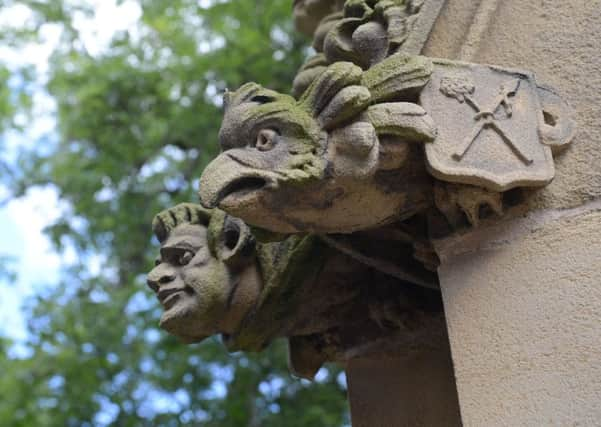How the People's Republic of South Yorkshire owes a debt of gratitude to family of Torys


In Labour-leaning Sheffield, “Tory” can sometimes seem a four-letter word in more ways than one. But the city wouldn’t look how it does today without a family with that politically- charged surname. From the 1880s to the 1950s, Frank Tory and his identical twin sons Alfred Herbert and William Frank ran a celebrated Sheffield-based firm of architectural sculptors. They carved statues, murals, friezes and memorials by the hundred. Glance upwards in many of the city centre’s streets, and, above the shop fronts and the “For Sale” signs, you’ll probably see examples of their intricate, immaculately executed work.
They weren’t confined to Sheffield, though. They worked in towns and cities across Yorkshire, including Leeds (on the Civic Hall), Bradford, York, Hull, Barnsley and Rotherham – and more widely throughout the North and Midlands.
Advertisement
Hide AdAdvertisement
Hide AdTheir work is as impressive as that of the architects whose buildings it enlivens. So to celebrate their legacy, Alfred’s granddaughter Gina Hodges and her husband Bob have published a lively new Sheffield sculpture trail. It takes in the City Hall, Mappin Art Gallery, Central Library and both cathedrals; it’s a fund of good stories and it offers a chance to raise your sights, literally.
“How often do people look up when they’re going through town?” asks Bob as we stand outside the City Hall. True enough. Crowds hurry past, consumed with their own business and busyness, rarely stopping shopping to stand and stare.
As Alfred once wistfully said: “It is a little disappointing sometimes to realise that work which has taken months of creative effort to produce is hardly noticed.”
Gina, a retired headteacher, grew up with her grandfather’s tales of the family’s exploits and remembers the Torys’ old home and workshops, now the popular Porter Brook pub. “I thought it was normal to have big slabs of stone and building materials lying around,” she says.
Advertisement
Hide AdAdvertisement
Hide AdBob, a retired careers adviser, didn’t think it was normal, however. He was fascinated by Alfred’s reminiscences during the last few years of his life (he died in 1971, aged 90) and thought the family deserved proper recognition.
“In Sheffield, we’re not always appreciative of what we’ve got,” says Gina. Alfred would probably have had none of it. “You wouldn’t have known from my grandfather that he was a creator of such beauty,” says Gina. “He never boasted; he was a very modest man.”
As he once poignantly said in a talk: “My life has passed from infancy to age with little to make a song about; brief shades and much sunshine.”
Frank Tory, born in 1848, trained at Lambeth School of Art and came to Sheffield in 1880 to work on carvings for the now-demolished Corn Exchange. His work, as elegant as the wing collar and Homburg he sometimes wore, so impressed city architects that he was persuaded to stay on. He set up a workshop near the subsequently built City Hall, which opened in 1932.
Advertisement
Hide AdAdvertisement
Hide AdWe step inside and gaze up at the ceiling of the grandly domed and gilded foyer, a riot of heraldic colour and decoration. The Torys – described as “exceptionally talented” by the definitive Pevsner Architectural Guide to Sheffield – made the moulds for the panels, as well as all the building’s stone and wood carvings and the imposing front and rear pillars.
Equally impressive are carvings for the Central Library, opened in 1934. High up on a corner sits a daunting Egyptianesque figure representing Knowledge.
Around the main entrance are attractive medallions highlighting the wonders within – literature (quill pens), music, drama, architecture, sculpture, painting (artist’s palette), mathematics, chemistry and astronomy (telescope). Hundreds of library users must pass them every day without noticing.
It’s said that when the Tory twins were on site together, other workers could only tell them apart because Alfred always wore a red tie. Unfortunately the only surviving photograph of them together – wielding chisels in near identical poses – is in black and white.
Advertisement
Hide AdAdvertisement
Hide AdBob tells another story about them working alternate weeks on a project in Hull. On Saturdays, one twin would buy a cheap day return rail ticket from Sheffield and, on arrival in Hull, give it to his brother to use when he took the train home later that day – “like good Yorkshiremen”. As Alfred recalled: “Although we met him constantly over six months, the architect never knew there were two of us.”
The Tory trail, researched at Sheffield Archives and Local Studies Library and drawing on the Pevsner guide, offers plenty of variety. There are grimacing gargoyles, easily missed carved heads of the future Edward VII and Queen Alexandra, and panels depicting the six days of creation (featuring Adam, Eve and plenty of fish). Chaucer and Caxton eyeball each other over an ornate window, weighing up who made the greater contribution to literature – writer or printer.
On a more human scale – and possibly the trail’s highlight – are the ten moulded Edwardian figures of Sheffield tradesmen on the front of the White Building in Fitzalan Square.
Most of the figures are cutlery workers, hunched over their benches, sleeves rolled up, impassively concentrating on their engraving or grinding, their buffing or forging. Sparks fly off a grinding wheel. A steelworker’s legs are wrapped round with sacking to protect them from molten steel.
Advertisement
Hide AdAdvertisement
Hide AdIt’s an affirmation of what made Sheffield great. A fine Tory tribute to labour.
The trail (£3) is on sale at three Sheffield shops: Sheffield Scene (Surrey Street), the Famous Sheffield Shop (Ecclesall Road) and Rhyme & Reason (Ecclesall Road). Or email [email protected] (£3.60 including postage).